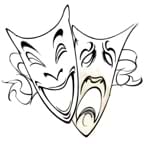A set of linked doodles
More from BooksThe niceties of Saul Steinberg’s cartoon drawings are doodle-related. Figures begin at the nose, become elaborately hatted and shod and strut like clockwork toys; words are transformed into free-standing objects; horizontal lines denote runways or table edges. Often, it seems, the draughtsman’s pen went on automatic, pen-pushing the same old absurdities, perplexities and double-takes on

